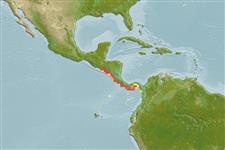Klassifizierung / Names
Namen | Synonyme | Catalog of Fishes (gen., sp.) | ITIS | CoL | WoRMS | Cloffa
Actinopterygii (Strahlenflosser) >
Perciformes (Perch-likes) >
Lutjanidae (Snappers) > Lutjaninae
Etymology: Lutjanus: Malay, ikan lutjan, name of a fish. More on author: Jordan, Gilbert.
Lebensraum / Klimazone / Range
Ökologie
; seewasser; brackwasser riff-verbunden; tiefenbereich 1 - 70 m (Ref. 9313). Subtropical, preferred ?; 36°N - 4°N, 90°W - 77°W (Ref. 55)
Eastern Pacific: southern California, USA to Panama; rare north of Baja California, Mexico. There are unsubstantiated reports of this species from localities as far south as northern Peru.
Size / Gewicht / Alter
Maturity: Lm ? range ? - ? cm
Max length : 91.0 cm TL Männchen/unbestimmt; (Ref. 2850); max. veröff. Gewicht: 9.3 kg (Ref. 40637)
Rückenflossenstacheln (insgesamt): 10; Rückenflossenweichstrahlen (insgesamt): 13-14; Afterflossenstacheln 3; Afterflossenweichstrahlen: 7 - 8. Preopercular notch and knob weak. Body and fins mostly red; sometimes with a blue streak under the eye. Young specimens are barred.
Adults inhabit inshore reef areas over hard bottoms. Generally solitary (Ref. 9313). Juveniles are sometimes encountered in shallow coastal waters and estuaries (Ref. 9313). Carnivorous, feed on invertebrates and fishes (Ref. 9313). Marketed fresh or frozen (Ref. 9313).
Life cycle and mating behavior
Geschlechtsreife | Fortpflanzung | Ablaichen | Eier | Fecundity | Larven
Allen, G.R., 1985. FAO Species Catalogue. Vol. 6. Snappers of the world. An annotated and illustrated catalogue of lutjanid species known to date. FAO Fish. Synop. 125(6):208 p. Rome: FAO. (Ref. 55)
IUCN Rote Liste Status (Ref. 115185)
CITES (Ref. 94142)
Not Evaluated
Bedrohung für Menschen
Harmless
Nutzung durch Menschen
Fischereien: kommerziell
Mehr Information
NamenSynonymeMetabolismusRäuberÖkotoxikologieFortpflanzungGeschlechtsreifeAblaichenFecundityEierEientwicklung
ReferenzenAquakulturAquakultur ProfilZuchtlinienGenetikAllel-HäufigkeitenVererbbarkeitKrankheitenVerarbeitungMass conversion
PartnerBilderStamps, CoinsLauteCiguateraGeschwindigkeitSchwimmstilKiemenoberflächeOtolithsGehirngrößeSehfähigkeit
Tools
Zusatzinformationen
Download XML
Internet Quellen
Estimates of some properties based on models
Phylogenetic diversity index (Ref.
82805): PD
50 = 0.5000 [Uniqueness, from 0.5 = low to 2.0 = high].
Bayesian length-weight: a=0.01202 (0.00706 - 0.02048), b=2.96 (2.82 - 3.10), in cm Total Length, based on LWR estimates for this species & Genus-body shape (Ref.
93245).
Trophic Level (Ref.
69278): 3.1 ±0.0 se; Based on diet studies.
Widerstandsfähigkeit (Ref.
69278): niedrig, Verdopplung der Population dauert 4,5 - 14 Jahre. (Preliminary K or Fecundity.).
Verwundbarkeit (Ref.
59153): Moderate to high vulnerability (54 of 100) .
